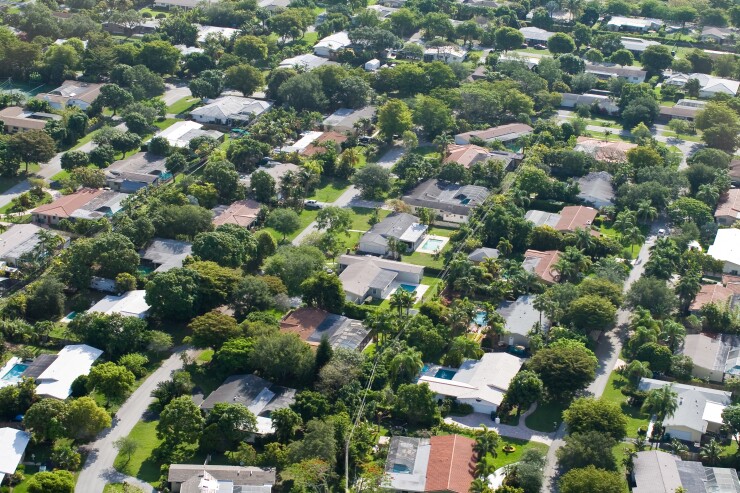A new study shows that Miami's affordable housing crisis is so dire, the city needs at least 50,000 units just to meet the existing need.
But the Connect Capital Miami Report, which was released Monday, also reveals a combination of tools and resources that could help alleviate the dearth of housing for cost-burdened residents.
According to the report, 71% of households in the City of Miami are renters, and 61% of those are cost-burdened, meaning they are paying more than 30 percent of their income in rent.
The recommendations of the report would result in the creation or preservation of 12,000 affordable housing units by the year 2024, according to Annie Lord, executive director of Miami Homes For All, a nonprofit advocacy group that combats homelessness.

"This plan wouldn't solve the entire problem, but it would take a sizable bite out of it," she said. "We're seeing a lot of support from city administrators, so it's about harnessing their excitement and interest into solutions."
The report identifies six potential development pathways for generating affordable housing units. Among them are the Rental Assistance Demonstration Project, a federal program that allows local governments to redevelop obsolete public housing by replacing every existing unit and increasing the number of affordable units while also adding market-rate units.
Another pathway for development is the preservation of naturally occurring affordable housing (NOAH) — older, distressed rental properties that are privately owned and not subsidized. These are the properties that are sold and demolished when a neighborhood goes through gentrification. For example, the percentage of NOAH units in Wynwood plummeted from 96% to 58% between the years 2000-2015, according to a recent study by the Urban Institute.
The report lays out specific development criteria for new affordable housing buildings, such as resiliency and environmental sustainability, and on-site supportive services such as child care and behavioral health care.
"We're in talks with [Housing and Urban Development secretary] Ben Carson about the possibility of HUD matching every dollar the city spends on affordable housing with a federal dollar," said Mayor Francis Suarez, who attended Monday's press conference. "So if we devote $100 million to affordable housing, it would turn into $200 million."
The most substantial portion of the report details specific ways to make the development and rehabilitation of affordable housing financially feasible.
Among them:
— Identifying adjacent parcels of publicly owned, vacant and underutilized land using the Land Access for Neighborhood Development tool developed by the University of Miami's Office of Civic and Community Engagement, which shows there are 500 million square feet of such land available around Miami-Dade County. The report recommends assembling available parcels for affordable developments through intergovernmental agreements, land swaps or a public land bank.
— Adjusting the Miami 21 zoning codes to allow developers to build higher-density buildings in height-restricted areas in exchange for affordable housing units or payments into a trust fund.
— Reducing property taxes on new affordable housing projects to incentivize developers and lenders and help preserve existing housing.
— A vacancy fee or tax on the estimated 31,779 vacant homes in Miami-Dade, owned by foreign or out-of-town buyers, that would generate an annual revenue of $98 million.
— Supplementing the existing $100 million portion of the Miami Forever Bond allotted for affordable housing with other funding streams, such a locally based Community Development Financial Institution that would finance long-term (30 years) affordable housing projects.
— Incorporating a real-time, publicly accessible system that would allow the city to track unit production of approved affordable housing developments, monitor compliance and modify housing policies as market demands shift. Washington, D.C., has had success with its "Affordable Housing Tracker" service.
The Connect Capital report is the result of nearly a year's worth of outreach meetings with community leaders, government officials, financiers and residents of low-income neighborhoods such as Overtown, Liberty City and Little Havana.
The effort was a collaboration between the City of Miami Department of Housing and Community Development, Miami Homes For All, South Florida Community Land Trust, Related Urban Group, Florida International University and other housing and community groups.
The study came three days after the Florida Senate approved the HB 7103 bill, which allows cities to require developers to set aside a percentage of units in new developments for low-income residents but requires any associated costs to be offset by incentives such as waived fees.
Lord said that several of the solutions proposed in the new report would be hampered if the bill is signed into law by Governor Ron DeSantis.
"This bill puts up more barriers and more costs for developing affordable housing," she said.
The City of Miami is preparing its own Affordable Housing Master Plan, due later this summer, that would lay out a 10-year time line for addressing Miami's housing crisis.
The Connect Capital Miami report was co-sponsored by JP Morgan Chase and the Center for Community Investment at the Lincoln Institute of Land Policy, a nonprofit group that researches effective land use and offers suggestions for public policy decisions.





